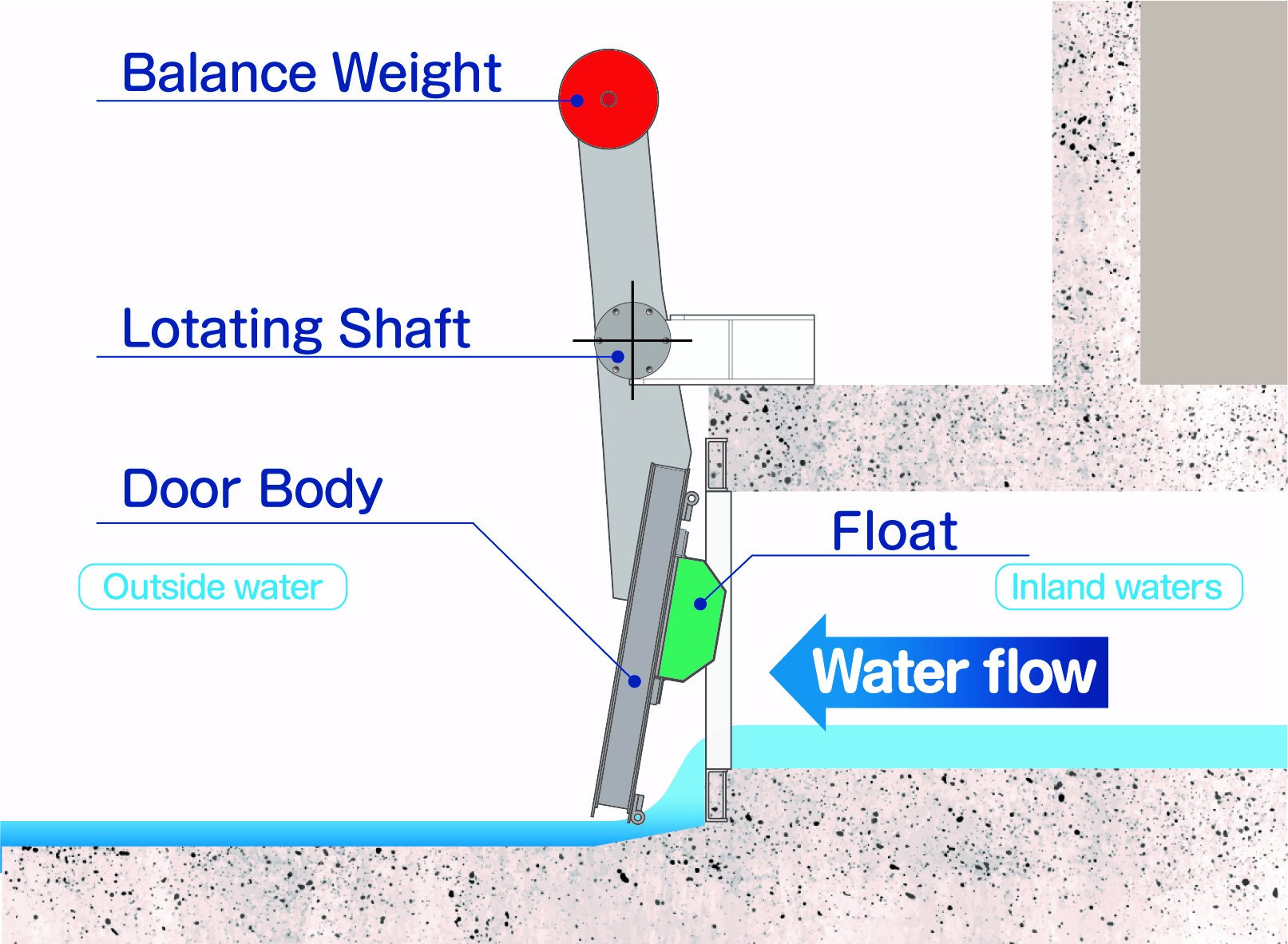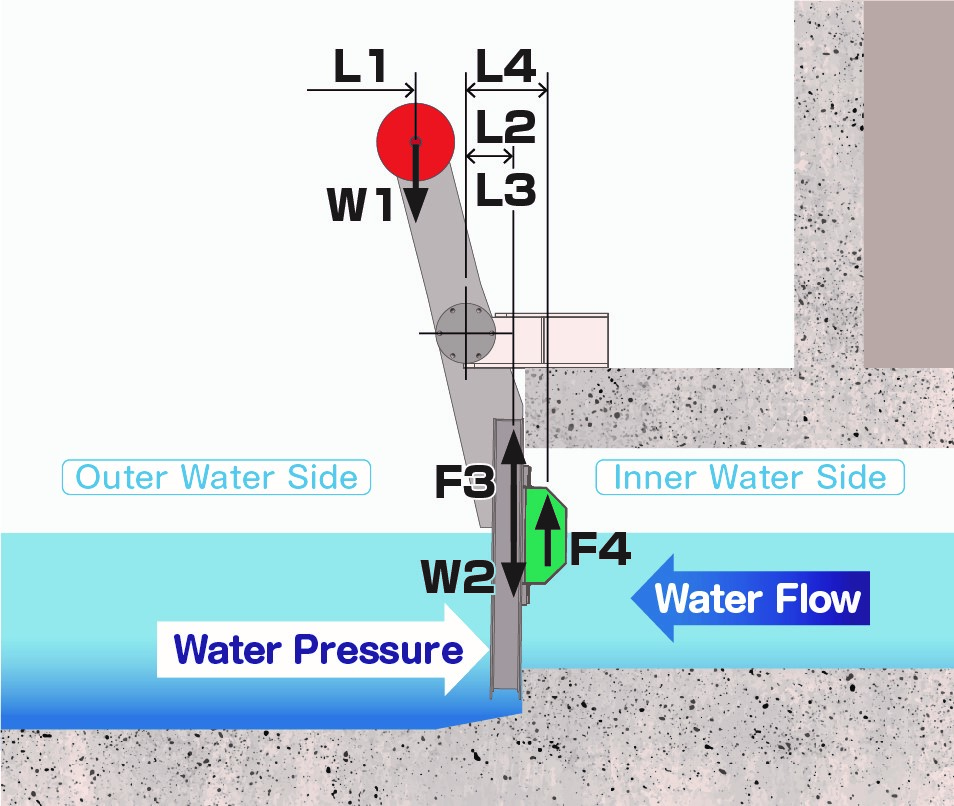
Bosai Solution ID : JBP00128

AUTO GATE
Non-powered automatic opening/closing gate
Hazard
Solution Purpose
Solution Theme
Technology Subject
Advantages
Comparison with pull-up gate
・Since it opens and closes automatically according to water level conditions, you will not miss
the timing of opening and closing even in the event of a sudden flood.
・This reduces the administrator's workload and eliminates human errors such as operational
delays and operational errors.
・Gate pillars and maintenance bridges are no longer required, reducing costs and construction
time.
・Since it is non-powered, it can be installed in locations where power sources such as
electricity cannot be secured.
・The automatic opening/closing mechanism is simple and easy to maintain, reducing
maintenance costs.
・The gatepost-less structure reduces the impact on the landscape.
・This eliminates the need to work at heights during construction, improving worker safety.
Solution Illustrated
 【Auto gate structure】
【Auto gate structure】
The auto gate (drawing below) is a gate equipment that has various improvements made by attaching balance weights, floats, etc. to a flap-type gate to solve the problems of conventional flap gates and improve the reliability of automatic opening and closing. is. Normally, the door body and balance weight are balanced by opening approximately 8 degrees. A balance weight is attached to the opposite side of the door via the rotating shaft, reducing the opening and closing force of the door using the see-saw principle. Due to this balance function, it has quick drainage performance even under normal conditions, and when removing inland water, the door body can be opened wide to allow a large amount of drainage to flow, and floating matter such as garbage can also flow down at the same time. In addition, when the outside water level has risen to prevent backflow, this gate equipment can automatically close the gate without power by using a float attached to the back of the gate.

Background
 【Popularization of auto gates】
【Popularization of auto gates】
Sluice gates temporarily close the gate to prevent backflow into tributaries (inside the levee) when the water level (outside water level) of the river rises due to heavy rain or typhoons, etc., to prevent flooding within the levee. Masu. As for the types of gates installed in sluice gates, pull-up gates such as roller gates and slide gates (drawing below) are often used, but the power for these gate opening and closing machines is electric (motor) or human power. It will be. Gates are operated by experienced operators, and in order to minimize damage, it is important for the operator to judge whether to open or close the gate. However, operating gates during floods is dangerous, and the aging and shortage of operators is also a problem, so automatic opening and closing of sluice gates is attracting attention. Especially for small-scale sluice gates, the installation of non-powered automatic opening/closing type gate equipment is increasing.

Exposition of the Solution
 【How the auto gate works】
【How the auto gate works】
The automatic opening/closing mechanism of the auto gate is achieved by placing balance weights and floats in a well-balanced manner. Due to the function of the balance weight, the opening/closing force of the automatic gate is approximately 1/5 of that of a flap gate.
「Normal time」
By placing the rotation axis in front of the door body, the center of gravity of the door body moves below the rotation axis, but the position where the door body stops in balance with the forward-tilted balance weight is as shown in the figure below. It will be open approximately 8 degrees.
W1 × L1(Weight self-weight moment)= W2 × L2(Door body weight moment)

「When removing internal water」
When the door opens under the dynamic pressure of the flowing water, the rotational moment of the balance weight acts in the direction of opening the door, making it possible to open the door wide with a small difference in water level. When the float comes into contact with water, the door opens further, but when the flow of water stagnates, the opening of the door quickly returns to its normal state.
W1 × L1 - W2 × L2 = Fw × Lw(Opening moment due to water pressure)

「When preventing backflow」
When the water level rises, the buoyancy of the gate body and the buoyancy of the float act as a rotational moment in the direction of closing the gate body, completely closing the gate. The water depth at which the valve is fully closed is normally designed to be 70% of the outlet height, but by changing the float installation position, the water depth at which it is fully closed can be changed (30 to 80% water depth).
Even when the gate is fully closed, if the internal water level rises above the external water level, the gate opens slightly and drains the internal water.
W2 × L2 - W1 × L1 ≦ F3 ×L3 + F4 × L4(Closing moment due to buoyancy of door body and float)

【Auto gate effect】
The function of automatically opening and closing without power not only reduces the labor of the operator, but also enables reliable flood control management without missing the timing of opening and closing the gate. Heavy rains have been occurring frequently in recent years, and we can respond accurately to such sudden flooding. Additionally, when river water levels rise, local residents, including operators, may be advised to evacuate, but even in such cases, the gate has a function to automatically close, minimizing damage to the local area. It is possible to quickly stop the water and deal with it after the water rises.
Achievements of Examples
Gate size: 4.50m x 2.70m , quad
Location: Asahi City, Chiba Prefecture

Facility name:Kamikura River Drainage Sluice
Gate size: 3.20m x 2.00m , double
Location: Yamada Town, Iwate Prefecture

Facility name:Izaributo Minami No. 22 Sluice
Gate size: 3.20m x 2.00m
Location: Titose City, Hokkaido

Other References
Corporate Profile
ASAHIINOVEX Corp.
2-20-15,Asakusabashi,Taito-ku,Tokyo 111-0053,Japan,Asakusabashi Mihama Building MainBuilding
Tel. : +81-3-5829-6121
E-mail : i-fujiwaraasahi-grp.co.jp
Website : https://www.asahi-inovex.co.jp/en/


.jpg)
.jpg)
.jpg)
.jpg)
.jpg)
